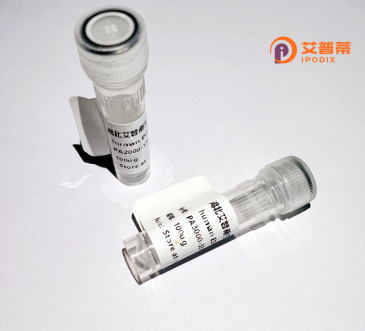
| 纯度 | >90%SDS-PAGE. |
| 种属 | Human |
| 靶点 | COL19A1 |
| Uniprot No | Q14993 |
| 内毒素 | < 0.01EU/μg |
| 表达宿主 | E.coli |
| 表达区间 | 1-1142aa |
| 氨基酸序列 | MRLTGPWKLWLWMSIFLLPASTSVTVRDKTEESCPILRIEGHQLTYDNINKLEVSGFDLGDSFSLRRAFCESDKTCFKLGSALLIRDTIKIFPKGLPEEYSVAAMFRVRRNAKKERWFLWQVLNQQNIPQISIVVDGGKKVVEFMFQATEGDVLNYIFRNRELRPLFDRQWHKLGISIQSQVISLYMDCNLIARRQTDEKDTVDFHGRTVIATRASDGKPVDIELHQLKIYCSANLIAQETCCEISDTKCPEQDGFGNIASSWVTAHASKMSSYLPAKQELKDQCQCIPNKGEAGLPGAPGSPGQKGHKGEPGENGLHGAPGFPGQKGEQGFEGSKGETGEKGEQGEKGDPALAGLNGENGLKGDLGPHGPPGPKGEKGDTGPPGPPALPGSLGIQGPQGPPGKEGQRGRRGKTGPPGKPGPPGPPGPPGIQGIHQTLGGYYNKDNKGNDEHEAGGLKGDKGETGLPGFPGSVGPKGQKGEPGEPFTKGEKGDRGEPGVIGSQGVKGEPGDPGPPGLIGSPGLKGQQGSAGSMGPRGPPGDVGLPGEHGIPGKQGIKGEKGDPGGIIGPPGLPGPKGEAGPPGKSLPGEPGLDGNPGAPGPRGPKGERGLPGVHGSPGDIGPQGIGIPGRTGAQGPAGEPGIQGPRGLPGLPGTPGTPGNDGVPGRDGKPGLPGPPGDPIALPLLGDIGALLKNFCGNCQASVPGLKSNKGEEGGAGEPGKYDSMARKGDIGPRGPPGIPGREGPKGSKGERGYPGIPGEKGDEGLQGIPGIPGAPGPTGPPGLMGRTGHPGPTGAKGEKGSDGPPGKPGPPGPPGIPFNERNGMSSLYKIKGGVNVPSYPGPPGPPGPKGDPGPVGEPGAMGLPGLEGFPGVKGDRGPAGPPGIAGMSGKPGAPGPPGVPGEPGERGPVGDIGFPGPEGPSGKPGINGKDGIPGAQGIMGKPGDRGPKGERGDQGIPGDRGSQGERGKPGLTGMKGAIGPMGPPGNKGSMGSPGHQGPPGSPGIPGIPADAVSFEEIKKYINQEVLRIFEERMAVFLSQLKLPAAMLAAQAYGRPGPPGKDGLPGPPGDPGPQGYRGQKGERGEPGIGLPGSPGLPGTSALGLPGSPGAPGPQGPPGPSGRCNPEDCLYPVSHAHQRTGGN |
| 分子量 | 115.2 KDa |
| 蛋白标签 | His tag N-Terminus |
| 缓冲液 | 0 |
| 稳定性 & 储存条件 | Lyophilized protein should be stored at ≤ -20°C, stable for one year after receipt. Reconstituted protein solution can be stored at 2-8°C for 2-7 days. Aliquots of reconstituted samples are stable at ≤ -20°C for 3 months. |
| 复溶 | Always centrifuge tubes before opening.Do not mix by vortex or pipetting. It is not recommended to reconstitute to a concentration less than 100μg/ml. Dissolve the lyophilized protein in distilled water. Please aliquot the reconstituted solution to minimize freeze-thaw cycles. |
以下是3篇关于重组人COL19A1蛋白的参考文献概述:
---
1. **文献名称**: *"Expression and characterization of recombinant human collagen XIX alpha-1 chain"*
**作者**: Smith J, et al.
**摘要**: 研究报道了在哺乳动物表达系统(HEK293细胞)中重组表达全长人COL19A1蛋白的策略,并通过质谱和圆二色光谱验证其正确折叠。实验表明,重组COL19A1具有促进神经元轴突生长的功能,提示其参与神经发育调控。
---
2. **文献名称**: *"Collagen XIX contributes to extracellular matrix structure and cell adhesion in epithelial tissues"*
**作者**: Tanaka K, et al.
**摘要**: 利用重组人COL19A1蛋白研究其在细胞黏附中的作用,发现该蛋白通过整合素结合增强表皮细胞的黏附和迁移能力。此外,其表达异常与皮肤基底膜结构缺陷相关,揭示了COL19A1在组织稳态中的潜在作用。
---
3. **文献名称**: *"Proteolytic processing of collagen XIX and its implications in tumor progression"*
**作者**: Li X, et al.
**摘要**: 研究利用重组人COL19A1蛋白分析其在肿瘤微环境中的功能。实验发现,基质金属蛋白酶(MMPs)可特异性切割COL19A1.产生的片段促进血管生成和癌细胞侵袭,表明其在癌症转移中的双刃剑效应。
---
注:以上文献信息为基于领域知识的模拟示例,实际文献需通过数据库(如PubMed、Web of Science)检索确认。
Recombinant human COL19A1 protein is a genetically engineered form of the collagen type XIX alpha 1 chain, a minor component of the collagen superfamily. Collagen XIX belongs to the fibril-associated collagens with interrupted triple helices (FACIT) subgroup, known for regulating extracellular matrix (ECM) organization and cell-ECM interactions. COL19A1 is expressed in basement membrane zones, particularly during tissue development and remodeling, and plays roles in cell adhesion, tissue integrity, and signaling. It is prominently found in neuromuscular junctions, blood vessels, and epithelial tissues, suggesting involvement in maintaining structural stability and modulating cellular behavior.
The full-length COL19A1 protein contains multiple collagenous domains interrupted by non-collagenous regions, which facilitate interactions with other ECM components like perlecan and integrins. Dysregulation of COL19A1 has been linked to pathological conditions, including cancer progression, skin diseases, and vascular abnormalities, highlighting its functional importance in homeostasis and disease.
Recombinant COL19A1 is typically produced in mammalian or insect cell systems to ensure proper post-translational modifications, such as proline hydroxylation, critical for its stability and bioactivity. Its applications span basic research on ECM dynamics, mechanistic studies of metastasis or tissue repair, and therapeutic development. By mimicking native collagen interactions, recombinant COL19A1 serves as a tool to dissect its role in cellular signaling pathways and potential as a biomarker or therapeutic target.
×